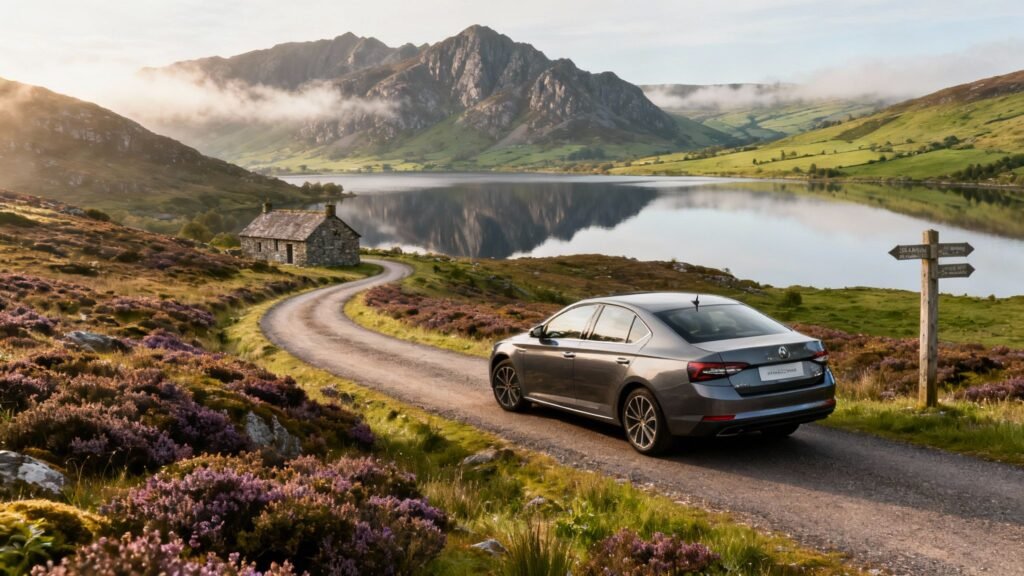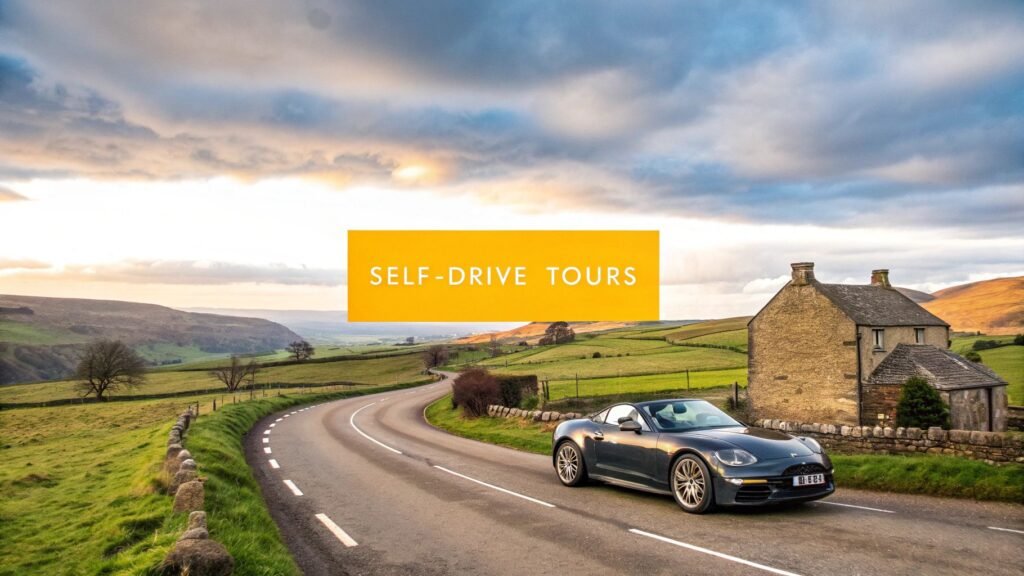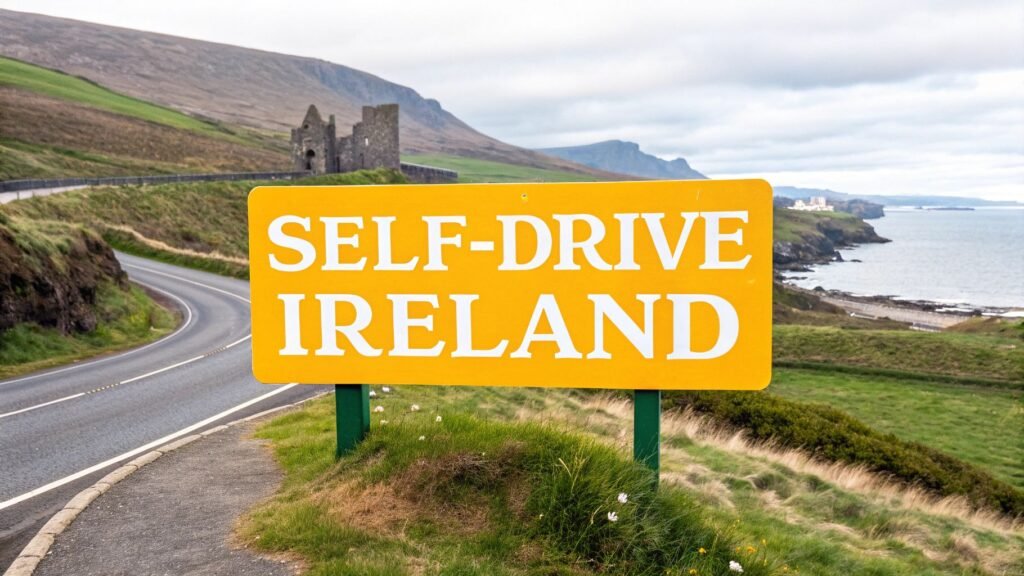There's nothing quite like the freedom of a Scotland Highlands tour where you're in the driver's seat. It gives you the chance to explore ancient castles, mysterious lochs, and sweeping glens entirely on your own schedule. This isn't just a holiday; it's your own story, written on the winding roads that cut through Scotland's raw, untamed heartland.
Why a Self-Drive Tour Is the Ultimate Highland Adventure
Forget being tied to a rigid itinerary or stuck on a crowded coach. A self-drive tour puts you firmly in control, turning a standard trip into a deeply personal expedition.
Imagine pulling over spontaneously because a stunning viewpoint demands your attention, or spending an extra hour at a hidden gem you stumbled upon by chance. That's the kind of freedom that truly defines the Highland experience.
And it seems the word is out. The Highlands have seen an incredible surge in visitors, with numbers jumping by a massive 64.7% between 2012 and 2023. This makes it the third most visited region in Scotland, a testament to its magnetic pull for adventurers and culture seekers alike.
The Benefits of Taking the Wheel
Opting to drive yourself unlocks a more authentic and adaptable way to travel. You stop being a tourist and become an explorer, carving out your own path.
- Unbeatable Flexibility: Fancy an impromptu hike up a Munro? Want to linger over a pint in a cosy village pub? You can. There's no bus schedule to worry about, just your own sense of adventure.
- A Deeper Connection: Driving allows you to get up close and personal with the landscape. You can stop in tiny hamlets, chat with locals, and find places far from the well-trodden tourist trails.
- Your Perfect Itinerary: You get to build a trip that's all about you. Whether you're chasing castle ruins, sampling single malts at remote distilleries, or hunting for that perfect photograph, the route is yours to design.
Think of this guide as your seasoned co-pilot. We're here to give you the insider knowledge and confidence to plan an incredible road trip, making the logistics part of the fun.
This guide goes way beyond the postcard pictures, giving you practical, real-world advice to help you navigate like a pro. We'll cover everything from building the perfect itinerary to uncovering secrets that only the locals know.
Whether you're planning a quick weekend getaway or an epic grand tour, you’ll find everything you need to make your journey unforgettable. For more ideas on what this incredible country has to offer, take a look at our complete collection of Scotland tours. Your Scottish saga starts now.
Crafting Your Perfect Highlands Itinerary
Putting together your ideal Highlands itinerary is a bit like composing your own personal adventure. You're the director, deciding which scenes to include, how long to linger in a breathtaking location, and what pace feels right. The goal is to create a seamless journey that ticks all your boxes, blending epic drives with unforgettable stops, all without feeling like you're in a constant race against the clock.
The secret to a great self-drive tour is a logical flow. You want to avoid spending your precious holiday time backtracking or crisscrossing the same ground twice. Think of it as creating a natural loop or a point-to-point journey that connects your must-see spots efficiently, leaving plenty of breathing room for those spontaneous detours that often become the best memories.
Choosing Your Route Framework
To get you started, let's look at three tried-and-tested frameworks for a multi-day Highlands tour. Each one has its own distinct personality and pace, designed for different trip lengths and interests. Don't think of these as strict rules, but rather as popular, well-trodden paths you can customise to fit your unique travel styles.
-
The Classic 5-Day Loop: This is a fantastic introduction for first-timers, packing a huge punch in a shorter timeframe. It typically starts in Edinburgh or Glasgow, heads north via the stunning Loch Lomond, cuts through the moody, dramatic landscape of Glen Coe, and takes you up towards Inverness and the famous Loch Ness. The return leg often winds through the majestic Cairngorms National Park, giving you a real highlights reel of Highland magic.
-
The 7-Day West Coast & Skye Explorer: If you have a couple of extra days, this route allows for a much deeper dive into the West Coast's raw beauty and the almost mythical landscapes of the Isle of Skye. It follows a similar path up to Glen Coe but then dedicates a good two or three days to exploring Skye's iconic sights like the Old Man of Storr and the Quiraing before you meander back down the spectacular coastline.
-
The Epic 10-Day North Coast 500 Explorer: This is the big one—the ultimate Scottish road trip. The NC500 covers over 500 miles of truly jaw-dropping coastal scenery, starting and ending in Inverness. This route takes you to the most remote and wild corners of mainland Britain, a place of pristine beaches, ancient ruins, and tiny fishing villages. You'll want to set aside at least seven to ten days to do it justice, but the rewards are absolutely worth it.
This infographic gives a great visual breakdown of what motivates people to explore the Highlands, whether it's the sheer freedom of the road, the pull of the scenery, or the chance to immerse themselves in local culture.
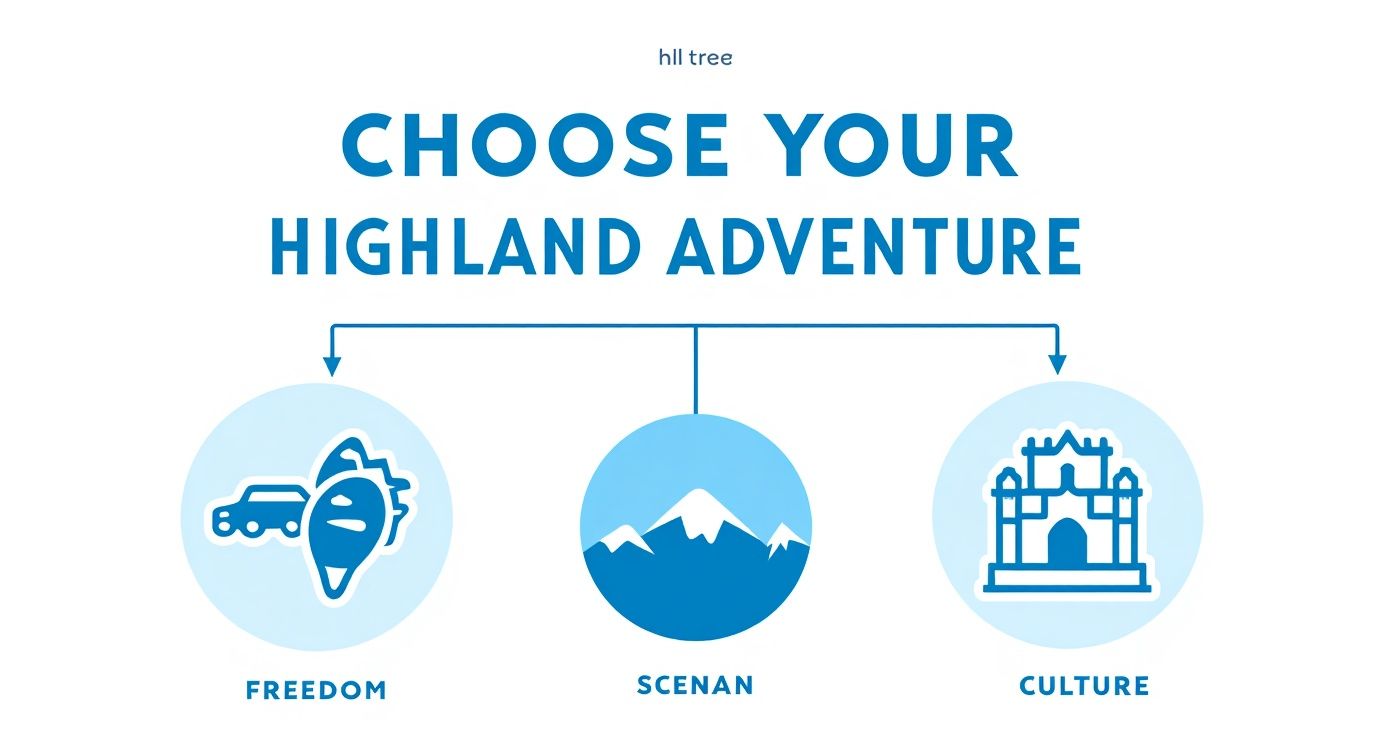
Figuring out what you value most will really help you pin down the right route and pace for a trip that feels tailor-made for you.
Structuring Your Daily Drives
Once you've picked your overall route, the next job is to break it down into daily, manageable chunks. One of the most common mistakes people make is trying to cram too much into each day. The Highlands aren't a place to be rushed; the journey between A and B is a massive part of the experience itself.
As a general rule of thumb, aiming for 100-150 miles (160-240 km) of driving per day is a solid plan. That might not sound like a lot, but on twisting, single-track Highland roads, that can easily take 3-4 hours of pure driving time. This pace leaves plenty of room in your day for sightseeing, a spontaneous hike, photo stops, or just enjoying a long, lazy lunch at a country pub.
A successful Highlands itinerary isn't measured by how many miles you cover, but by how many moments you collect. Prioritise depth over distance for a truly memorable experience.
To give you a clearer picture of how these popular routes compare, here's a quick look at what you can expect from each.
Comparing Popular Scotland Highlands Tour Itineraries
Choose the best self-drive route based on your trip duration and interests.
| Itinerary Name | Duration | Best For | Key Highlights |
|---|---|---|---|
| Classic Highland Loop | 5-6 Days | First-time visitors and those with limited time. | Glen Coe, Loch Ness, Cairngorms National Park, Inverness. |
| West Coast & Skye | 7-8 Days | Scenery lovers and photographers wanting to explore Skye in depth. | Eilean Donan Castle, The Old Man of Storr, Quiraing, Glenfinnan Viaduct. |
| North Coast 500 | 9-12 Days | Seasoned road trippers seeking remote beauty and adventure. | John o' Groats, Smoo Cave, pristine northern beaches, Applecross Pass. |
By choosing a route that lines up with your available time and what you truly want to see, you're setting yourself up for a stress-free and deeply rewarding adventure. This bit of planning upfront is what allows you to truly embrace the freedom of the road, confident that your ambitious journey is also a perfectly achievable one.
Exploring Must-See Sights and Hidden Gems
Right, you’ve got a rough idea of your route. Now for the fun part. A self-drive tour in Scotland isn’t just about the journey from A to B; it's about the jaw-dropping moments you find scattered in between. The Highlands are a treasure chest of both legendary landmarks and quiet, secret spots. Knowing where to look is what turns a good trip into a truly unforgettable one.
Think of this section as your guide to those unmissable, postcard-perfect sights, but also to the lesser-known gems that give you a real taste of the Highlands, away from the crowds. We'll go beyond the obvious and give you some practical advice for making every stop count.
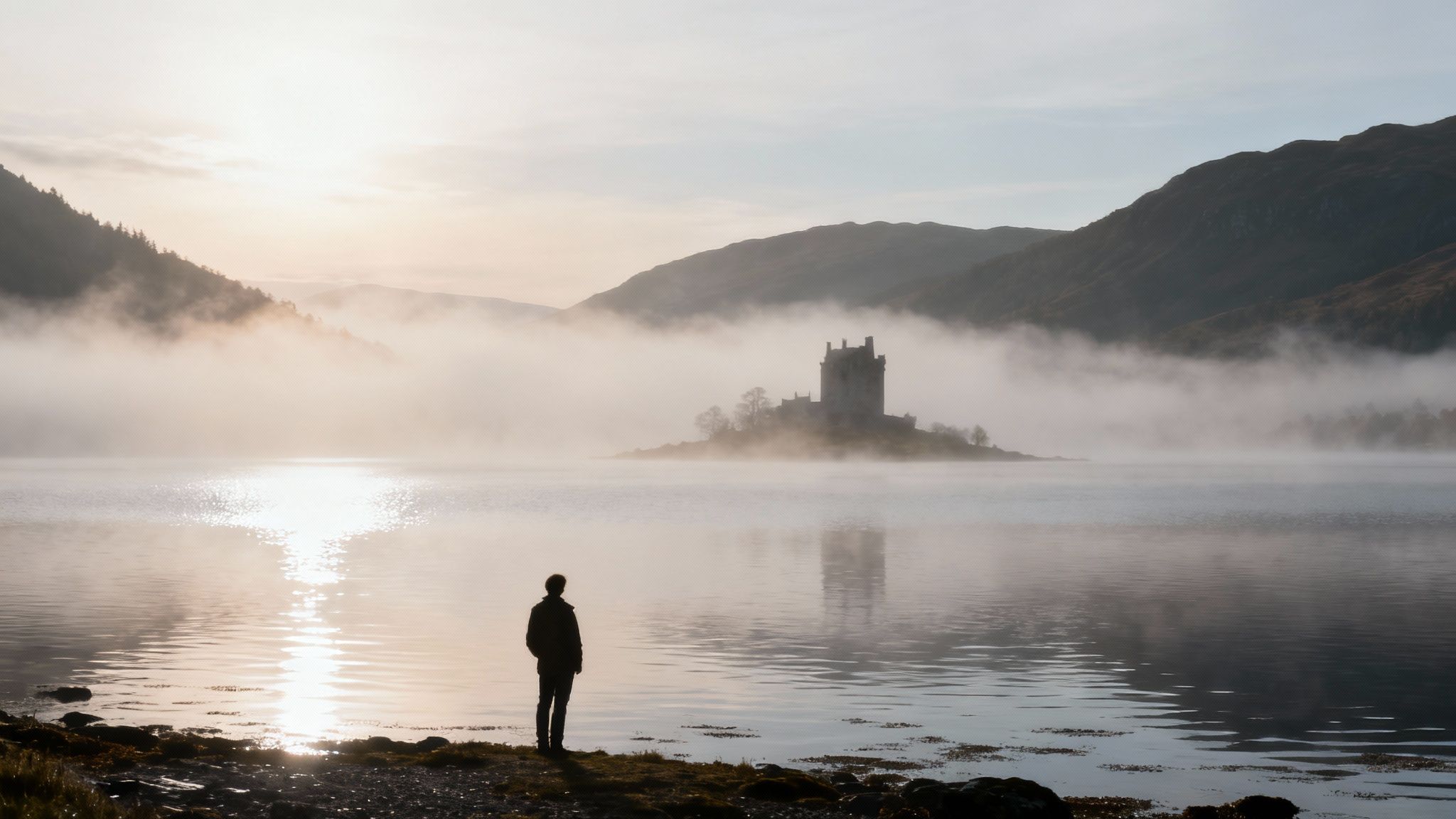
The Unmissable Highland Icons
Some places are famous for a reason. Their raw beauty and deep history have captivated travellers for generations. These are the absolute cornerstones for most Scotland Highlands tours, and honestly, you wouldn't want to skip them.
-
Glen Coe: This is, without a doubt, Scotland's most famous and atmospheric glen. Driving through it feels like you've stepped into another world, with the moody, imposing peaks of the Three Sisters flanking the road. Its haunting beauty is only deepened by its tragic history—the infamous Glencoe Massacre of 1692. Make sure you leave enough time to pull over at the viewpoints and just breathe it all in.
-
Loch Ness & Urquhart Castle: You can't come to the Highlands and not visit Loch Ness. While you might not catch a glimpse of Nessie, the sheer size of the loch is staggering; it holds more fresh water than all the lakes in England and Wales put together. For many, the real showstopper is the ruin of Urquhart Castle, perched dramatically on the loch's edge, offering breathtaking views and a direct link to Scotland's turbulent past.
-
The Isle of Skye: Skye is a world unto itself, a place of almost mythical landscapes that feel conjured from a fantasy novel. Driving the Trotternish Peninsula loop is non-negotiable, as it takes you past iconic sights like the jagged Old Man of Storr, the dramatic, tumbling cliffs of the Quiraing, and the whimsical Fairy Glen.
-
Eilean Donan Castle: Sitting at the meeting point of three great sea lochs, this is probably the most photographed castle in all of Scotland. Its fairytale silhouette, joined to the mainland by an old stone bridge, is a sight you won't forget, especially at high tide when it looks like it's floating on the water.
Venturing Off the Beaten Path
The real magic of having your own car is the freedom to get lost a little and discover places that aren’t on every tourist itinerary. These hidden gems offer the same incredible beauty as their famous cousins but with a fraction of the people, giving you a far more personal and peaceful experience.
Escaping the crowds doesn't mean compromising on spectacle. The Highlands' best-kept secrets are often just a short detour away, rewarding curious travellers with pristine landscapes and profound tranquillity.
Why not try adding a few of these incredible, less-travelled spots to your route?
Glen Etive
Often called Glen Coe’s quieter, wilder sibling, this stunning valley is reached by a single-track road just off the A82. The drive itself is an adventure, winding along the River Etive as it tumbles and cascades its way to Loch Etive. It’s a favourite spot for wild campers and photographers, offering raw, untouched beauty.
The Northwest Coast Beaches
Scotland might not be the first place you think of for a beach day, but the northwest coast hides some of the most stunning white-sand bays in the world. Places like Achmelvich Beach and Sandwood Bay have almost Caribbean-like turquoise water set against a backdrop of rugged mountains. They take a bit more effort to get to, but the reward is immense.
Charming Fishing Villages
All along the coast, you'll find countless tiny villages that look like they're frozen in time. Instead of making a beeline for the bigger towns, take a detour to explore communities like Plockton (known as the "Jewel of the Highlands" for its surprising palm trees), Shieldaig, or Ullapool. They're perfect for enjoying incredibly fresh seafood and soaking up authentic local life. For those who want a curated journey into this world of flavour, our Taste of Scotland 8 Days Self-Drive Tour is built around these experiences.
By balancing the iconic sights with these hidden treasures, you can craft a journey that is both epic and deeply personal, creating memories that will last a lifetime.
Navigating the Roads of the Scottish Highlands

Getting behind the wheel in the Scottish Highlands is an experience in itself—it's a massive part of the adventure. The roads snake through majestic glens and trace the edges of breathtaking lochs, but they also bring their own set of unique challenges. Think of this as your essential driver's briefing, designed to give you the confidence to handle everything from narrow single-track roads to the odd wandering sheep.
First things first: the car. When you’re booking a hire car, my advice is to think smaller. A big, bulky SUV might look the part, but a more compact vehicle is far more nimble on the narrow, twisting roads you'll spend most of your time on. You absolutely do not need a 4×4; a standard car will get you everywhere you need to go. If you're not used to driving a manual, make sure you book an automatic well in advance—they're often the first to go.
The roads themselves are generally in good nick, but the style of driving is a world away from the motorways down south. Once you leave the cities, dual carriageways are a distant memory. You'll be getting acquainted with A-roads (the main arteries) and B-roads (the smaller, local routes), which are often just two lanes wide, and you'll need to get comfortable with roundabouts.
Mastering Single-Track Roads
The most unique, and for some, the most intimidating, part of driving in the Highlands is the single-track road. These are properly paved roads, but they’re only wide enough for one car at a time and are very common in the more remote areas and on the islands. They really aren't as scary as they sound once you get the hang of the passing places.
These are little lay-bys or wider bits of road that pop up every hundred metres or so. The etiquette is simple: the car that's closer to a passing place on their left should pull in to let the oncoming vehicle go by. If the passing place is on your right, you stop on your side of the road, opposite the lay-by, which allows the other driver to pull into it to pass you.
A friendly wave to the other driver is part of the deal and always appreciated. And a critical point: never, ever use a passing place to park up for a photo. They are absolutely essential for keeping the traffic moving, however light it may be.
Driving in the Highlands is a dance of courtesy and awareness. It’s about slowing down, anticipating the road ahead, and working with other drivers to share the beautiful but narrow tarmac.
Driving Etiquette and Practical Tips
Beyond the mechanics of the road, a few local customs and practical tips will make your journey that much smoother. Highland driving has its own distinct rhythm, and if you lean into it, you'll have a much better time.
- Fuel Up Frequently: Out in the wilds, petrol stations can be few and far between, and many close much earlier than you'd expect. A golden rule is to fill up whenever your tank hits the halfway mark.
- Watch for Wildlife: It's no joke—sheep, deer, and Highland cattle (the famous "hairy coos") have a habit of wandering onto the roads. Be extra cautious around dawn and dusk.
- Navigation Know-How: A sat-nav or your phone's GPS is a great help on the main roads, but they can become pretty useless in remote areas with patchy signal. Always have a good old-fashioned paper map tucked away as a backup.
- Stay Left: This one is crucial for visitors from abroad. Always, always drive on the left side of the road. It’s easy to forget, especially when pulling out of a junction or navigating a roundabout after a break.
- Consider Conditions: The weather here can turn on a sixpence. When you're on winding Highland roads, particularly in the cooler months, good grip is key for staying safe. It's worth understanding traction and tires in colder climates before you set off.
By embracing a slower pace and staying alert, you'll discover that the driving is one of the most rewarding parts of any Scotland Highlands tour. For some route inspiration and vehicle ideas, feel free to explore our range of expertly planned self-drive tours.
Finding the Perfect Highland Accommodation
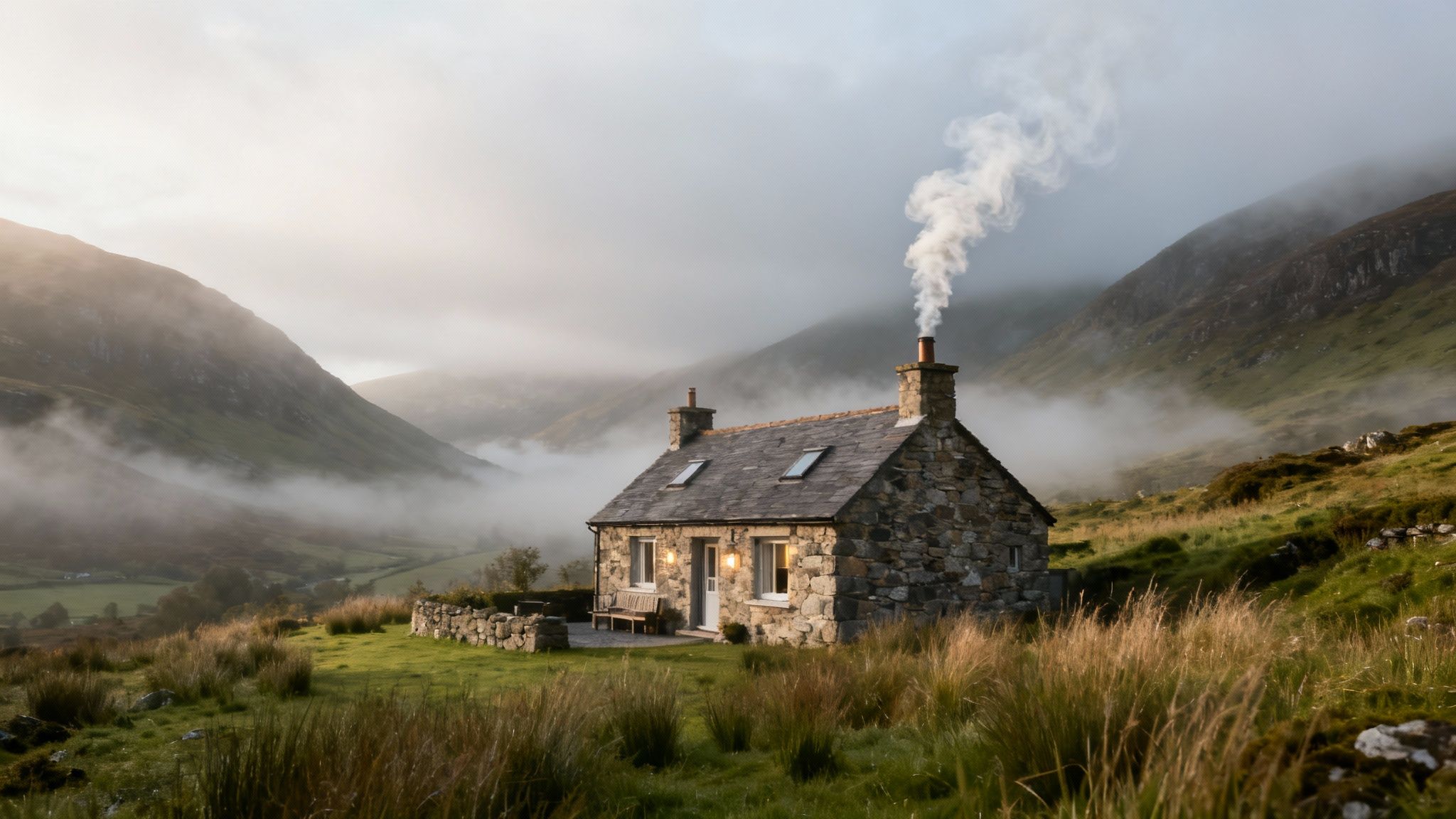
Where you rest your head each night is just as much a part of your Highland story as the landscapes you explore by day. The right accommodation isn’t just a bed for the night; it’s a warm welcome after a day of navigating winding roads, and a chance to truly connect with the place. Getting your stays sorted is a huge step in crafting your perfect Scotland Highlands tour.
The Highlands serve up a brilliant variety of places to stay, each with its own character. You could find yourself in a traditional Bed & Breakfast, getting local secrets from your host over a full Scottish breakfast, or a lively inn with a crackling fire and a pub buzzing with stories. The choice is yours.
Choosing Your Style of Stay
First, think about the kind of trip you’re after. Do you want the freedom of your own space, the charm of a local host, or the buzz of a larger town? Each option offers a completely different flavour of Highland life.
- Bed & Breakfasts (B&Bs): These are often family-run spots that offer a genuinely personal touch. They’re perfect if you love chatting with locals and getting insider tips on the best nearby walks or hidden viewpoints.
- Traditional Inns & Pubs: Fancy staying above a historic pub? This is about as immersive as it gets. It’s a fantastic way to enjoy hearty food, local ales, and maybe even some live music without worrying about who's driving home.
- Self-Catering Cottages: Ideal for families, groups, or anyone on a longer trip who wants a bit of independence. A cottage gives you the freedom to cook your own meals and create a real home-from-home.
- Hotels: You’ll find most hotels in hubs like Inverness and Fort William. They offer more amenities and are always a reliable choice. If you’re driving an electric car, you might want to prioritise places with charging facilities – a welcome trend you can read more about in this guide on EV charging at hotels.
With the Highlands’ popularity soaring, the hotel market is growing to keep up, especially in key cities like Inverness. It's a clear sign of the region's ever-increasing appeal.
Strategic Overnight Bases
Deciding where to stay is just as crucial as the type of place you choose. Picking a good base of operations can slash your driving time and let you see more. For a classic Highland tour, think about breaking your journey in a place like Fort William, the gateway to the dramatic scenery of Glen Coe and the mighty Ben Nevis.
Portree is the undisputed hub for exploring the Isle of Skye, while Inverness is the natural starting and finishing line for the legendary North Coast 500 route. The real key to a seamless trip is booking your accommodation logically along your planned route.
The golden rule for Highland accommodation? Book well in advance. During the peak season from May to September, the best and most charming places are often snapped up months—sometimes even a year—ahead of time.
Leaving your bookings to the last minute, particularly in hotspots like Skye or along the NC500, often leads to frustration or settling for a place miles off your intended path. A bit of forward planning ensures you get the experience you’re dreaming of, at a price that works for you, making your Scottish adventure all the more authentic.
Insider Tips for an Authentic Scottish Adventure
There’s a world of difference between a good holiday and a truly unforgettable adventure. That difference often comes down to a bit of local know-how. These are the little secrets that can turn standard Scotland Highlands tours into the kind of experience you’ll talk about for years.
First things first, let’s talk timing. Summer gives you glorious long days, but it also brings peak season crowds and the infamous Scottish midge. These tiny terrors are at their worst in July and August, especially in the still, damp air common along the West Coast.
For a more pleasant trip, I always recommend the shoulder seasons. May and June often have the best weather of the year, with wildflowers in full bloom and far fewer midges. September and early October are just as magical, with the landscape turning fiery shades of red and gold.
Packing for Four Seasons in a Day
You've probably heard the saying: if you don’t like the weather in Scotland, just wait five minutes. It's not an exaggeration! The key to staying comfortable is mastering the art of layering. A simple system—base layer, fleece, and a waterproof/windproof shell—will prepare you for whatever the Highlands throws your way.
Even on a bright, sunny morning, the weather can shift in a heartbeat, particularly if you're heading for the hills. A warm hat, gloves, and waterproof trousers should always be in your pack, alongside a good pair of sturdy walking shoes. You’ll be glad you have them when a sudden downpour sweeps across the glen.
Embracing Local Culture and Etiquette
A truly authentic trip means connecting with the local culture, and that starts with respect. The best way to do this outdoors is by following the Scottish Outdoor Access Code. It’s not complicated; it’s all about enjoying the land responsibly.
The code boils down to three simple principles: respect the interests of others, care for the environment, and take responsibility for your own actions. In short: leave no trace, be mindful of wildlife, and park considerately.
This mindset of respect carries over into everything else. Skip the big chains and hunt down a tiny, independent seafood shack for the freshest langoustines you’ll ever taste. Duck into a local pub for a pint and a chat with the regulars.
And when it comes to whisky, remember that every distillery has its own personality. Some offer highly technical production tours, while others are all about the curated tasting experience. A little homework will help you find the perfect one for you, whether you're a curious novice or a seasoned enthusiast.
Your Top Scotland Highlands Tour Questions Answered
Even the most organised traveller has a few last-minute questions before heading off on a big adventure. It's completely normal! So, let's run through some of the most common things people ask when planning their own Highlands road trip.
Think of this as your final pre-flight check before you hit the road.
How Many Days Do You Really Need in the Scottish Highlands?
To get a real feel for the place, you'll want to give yourself at least 5 to 7 days. That's a good amount of time to properly explore a major area, like the West Coast and the Isle of Skye, without constantly watching the clock. It strikes a nice balance between driving and actually getting out of the car to see things.
If you’ve got your heart set on an epic journey like the North Coast 500, I’d strongly suggest blocking out 7 to 10 days. Any less and you'll be rushing through some of the most spectacular scenery. A longer trip gives you the breathing room to enjoy the remote landscapes, detour down that interesting-looking lane, and really soak it all in.
What Is the Best Month to Visit the Scottish Highlands?
May, June, and September are my personal favourites. You get lovely long days in May and June, the wildflowers are out, and—most importantly—you miss the worst of the infamous midges.
September is a brilliant alternative, bringing with it stunning autumn colours and fewer people than you'll find in the peak summer months. July and August are certainly the warmest, but they’re also the busiest, and you’ll be sharing the views with both the crowds and the midges.
Choosing when to go is all about balancing weather, crowds, and daylight. The "shoulder seasons" of late spring and early autumn almost always offer the best combination for a fantastic road trip.
Do I Need a 4×4 to Drive in the Highlands?
Not at all. A big 4×4 is definitely not a requirement for a Highlands road trip. Almost all the roads you'll be on, including the entire North Coast 500 and the main routes on Skye, are well-paved and perfectly manageable in a standard car.
In fact, a smaller, more nimble car is often a much better bet. You’ll find it far easier to navigate the narrow single-track roads and squeeze into parking spots in tiny fishing villages.
Should I Carry Cash in the Highlands?
Yes, absolutely. Having some cash on you is a very good idea. While you can use your card in bigger hotels, restaurants, and attractions in towns like Inverness, you'll quickly find that many smaller, independent places in rural areas are cash-only.
This is especially true for little B&Bs, local craft shops, roadside honesty boxes selling fresh eggs, and cosy cafes in the middle of nowhere. Keeping some Pounds Sterling in your wallet means you won't miss out on those brilliant, authentic experiences.
At BTOURS, we take all the guesswork out of planning. Our self-drive itineraries are designed by experts who know these roads inside and out, making sure you see the best of the Highlands with great places to stay and a route that mixes iconic sights with incredible hidden gems. Discover your perfect Scottish road trip today.

